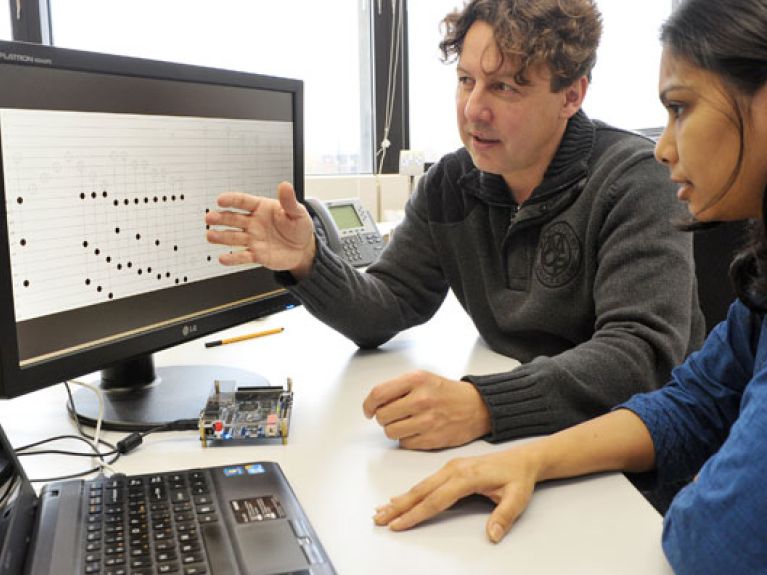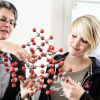Joint research to promote energy innovation
A look at two outstanding examples of transatlantic research cooperation.

In the first quarter of 2014, Apple announced that 65 billion apps have so far been downloaded from the iTunes store. Whether it’s news, games, videos or educational applications – smartphone and tablet users love these little programs. And mobile devices offer increasingly sophisticated capabilities: their camera resolution is constantly improving and the apps feature elaborate graphics. But there’s one thing spoiling the fun: smartphones need recharging after several hours of use. The batteries run down – and there’s no major breakthrough in sight in battery research.
That’s why computer scientists and electrical engineers are looking for new ways to save energy. Rolf Drechsler, head of the Computer Architecture Group at the University of Bremen, has joined forces with Kaushik Roy of Purdue University in West Lafayette, Indiana, for this very purpose. According to the Academic Ranking of World Universities, Purdue University ranks among the world’s top ten in engineering and computer science – and Kaushik Roy is one of the leading experts on low-power design, the development of energy-efficient electrical engineering products. Together with their teams, Drechsler and Roy are seeking to develop microchips that waste a lot less energy than they used to. The German Academic Exchange Service (DAAD) has been supporting the transatlantic partnership since the beginning of 2013, with funding continuing for a total of two years.
The two research teams want to use so-called reversible logic on chips: “Think of the inside of a computer chip as consisting of millions of little switches,” says Drechsler. “With each computer operation, the switches are flicked and pass on a new piece of information – the old information that triggered the switch being lost in the process.” This also means that energy is lost. But that need not be the case. Drechsler and Roy want to design the computer architecture in such a way that all existing information is preserved, enabling it to be used multiple times during the computing process. Drechsler compares the principle with energy recovery in cars. “In some cars, the energy generated during braking is subsequently used to power the engine – we want to do something similar in computers,” he explains. But it has yet to be proved that reversible logic works: the aim of the research project is nothing less than to provide the first empirical proof of this.
The researchers are optimistic that together they can succeed. Both sides are very happy with the German-American cooperation. “We have complementary competences,” says Roy. “I’m working more on the hardware and circuits, while Rolf Drechsler is focusing on logic synthesis and verification.” The two researchers know and trust each other. Roy and Drechsler first met as PhD students and have co-authored a number of papers. Now, thanks to funding from the DAAD, they can not only benefit from their expertise again but also offer their students an attractive exchange opportunity. “My experience with German students has been very positive,” says Roy. “They have a sound knowledge of their subject and are very reliable team members.” Drechsler adds: “We don’t view the project as a one-off collaboration – it’s a basis for long-term cooperation.”
Similar goals are being pursued by the Fraunhofer Institute for Ceramic Technologies and Systems IKTS in its cooperation with the University of Connecticut, where Fraunhofer USA opened the Fraunhofer Center for Energy Innovation CEI in July 2013. Fraunhofer USA is a 100% subsidiary of Fraunhofer Deutschland. The partners want to cooperate in several areas simultaneously. “Fraunhofer CEI pools the founding partners’ expertise to develop and commercialize new materials and technologies with a view to improving future energy recovery and storage,” says Prabhakar Singh, CEI’s head. The goal, he explains, is to speed up the provision of inexpensive and sustainable energy supply technologies globally.
“CEI is still in the structuring phase,” says Mihails Kusnezoff, head of the Materials and Components department at Fraunhofer IKTS. “At the moment, we’re looking for industrial partners in the United States in order to launch projects. An industrial workshop is being held in June 2014 for this purpose.” The research will then concentrate on new materials – such as metals, ceramics, micro- and nanostructures – for use in batteries and energy storage. “In the joint projects, we’ll be searching for new approaches off the beaten path – looking, if you like, for the next catalyst in energy technologies,” says Kusnezoff. Fraunhofer CEI has start-up funding for the next four years and the cooperation is also being supported by the Connecticut Department of Energy & Environmental Protection (DEEP). In Connecticut, there has been keen interest in the German researchers since the Obama Administration’s announcement last year that it intends to build a National Network for Manufacturing Innovation modeled on Germany’s Fraunhofer Institutes.
IKTS already has experience of working with U.S. industry. In 2012, together with American fuel cell manufacturer FuelCell Energy, it founded FuelCell Energy Solutions GmbH, where researchers from both sides of the Atlantic are developing new fuel cells. The cooperation with the University of Connecticut is not just about exchanging ideas either – IKTS has already sent its first researcher to work for a year in the U.S. “We don’t want separate research communities working in isolation. What we want is to work together to be successful in the long term,” says Kusnezoff. So the next big energy innovation could well be the result of German-American cooperation. ▪
Boris Hänßler

